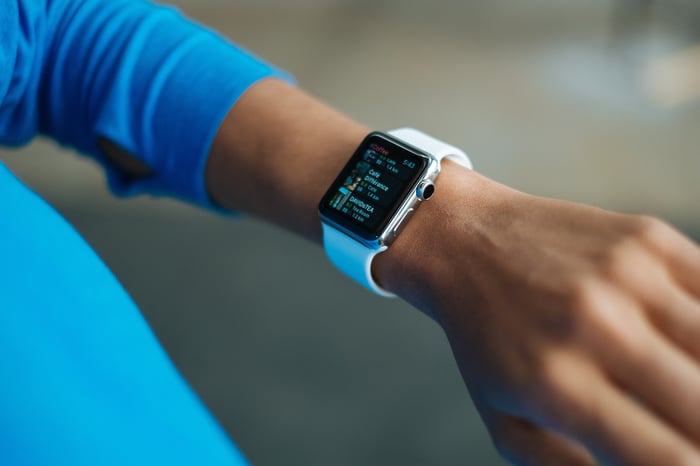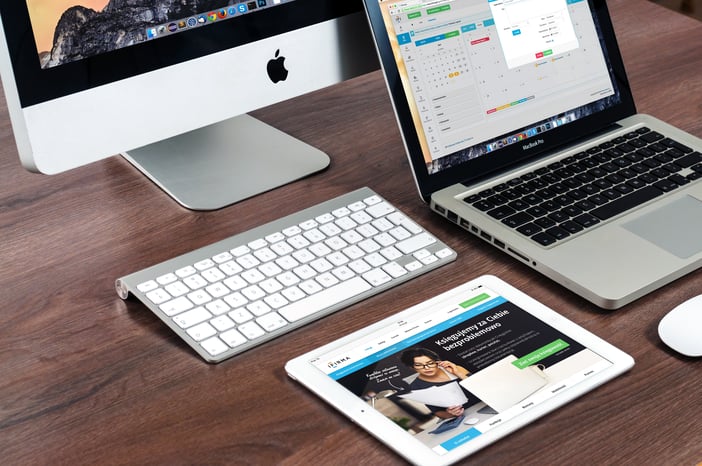July 30, 2018
 by Alan Santillan / July 30, 2018
by Alan Santillan / July 30, 2018

Android and iOS are the two largest mobile software platforms in the world. Why exactly is that?
There are other other options, but in terms of functioning software, they are extremely limited. According to Statcounter, Android and iOS accounted for approximately 95 percent of the global smartphone market in Q1 of 2018. Since the fall of Symbian OS, the market has only become less saturated with competitors.
Amazon has had its attempt at an operating system only to see it flop with the Fire Phone. Microsoft dropped Windows Phone, and classic brands like Nokia and Blackberry have moved on to producing hardware for Android. Barriers to entry are higher than ever in the mobile space, but that's not a problem for end users.
G2 Crowd has gathered hundreds of reviews on these platforms from business-minded professionals and overall ratings tell a parallel story to what we have seen unfold in the past decade.
A couple hundred reviews are available for both Android and iOS, while their former competitors only have just over 10.
Windows Phone shows promise in terms of high ratings; however, that is not enough for the direction Microsoft has chosen to go with its project.
Windows devices will continue to receive security updates for the foreseeable future, but Microsoft will no longer be adding new features to their devices. It has switched gears towards developing for Android in an attempt to recapture some of the market.
With the introduction of its Windows Launcher for Android, users can now experience some of those Windows Phone aesthetics on Android.
Blackberry has also been in the process of transitioning its OS to an Android skin as a result of the faltering support for its product. User reviews ranked Blackberry OS as the product with the least positive overall direction.

When considering buying options for mobile devices, such as smartphones and tablets, one of the most important factors is the operating system the device runs. The times of Symbian OS, HP’s long lost Palm OS, and the nameless other competitors that used to battle for a share of the pie no longer exist.
Your only options are Android or iOS, but that's okay because those operating systems offer just about anything a buyer could ask for out of a mobile device. Whether it's a company or an individual, a buyer’s considerations when purchasing an operating system must focus on their demand of specific features and functionalities.
|
TIP: Learn more about the other mobile operating systems and how developers effectively build apps for more than one. |
Let’s go ahead and discuss some of the more common factors buyers should consider when purchasing a mobile device and why Android and iOS really are the only way to go.
Android and iOS are the two largest mobile operating systems on the market, so it makes sense that they will continue to be supported and developed.
Support for application development, software patches, security updates, and a number of other resources are what make these two your only real options.
Blackberry 10 and Windows Phone OS support has disappeared since the two fell out of the market. You can still pick one up, but you’ll be working with outdated software and limited security updates.
With current standards in place, most Android and iOS devices receive wireless software updates for two major update cycles. That’s an ideal situation for most buyers because of the current timeline that carriers have set for end user upgrade patterns. Additionally, mobile device contracts and payment plans last approximately two years for end users. At that point, most customers will be looking to upgrade or replace their device.
“When it comes to development of apps for this platform, it's too difficult for a developer developing apps for Android & iOS to develop for WP due to Microsoft using it's own platform tools and language framework.” - Validated Windows Phone G2 Crowd User Review
Businesses considering handsets for day-to-day operations have a greater benefit with Apple devices, as the iOS operating system holds longer upgrade windows (no pun intended) for its devices.

Android is more on the disposable side, so devices tend to have shorter lifetimes, but that’s great if a business is looking for a pilot program with employee handsets or is running on a tighter budget.
Carrier support in the United States is particularly hard to get around for fringe operating systems. There are options to make devices with GSM radios that support AT&T and T-Mobile’s radio frequencies, but most users purchase their devices through brick and mortar carrier stores with financing contracts in order to make the climbing prices more affordable.
Buyers will have limited success in trying to replace their current device on a Verizon or Sprint contract with the CDMA radios that aren’t supported by most unlocked phones.
An operating system’s functionality largely relies on its application selection and the duopoly towers over its nonexistent competition.
Android and iOS boast the two largest mobile app stores. At 3.6 million and 2.5 million unique apps, respectively, you can be safe to assume application developers will continue to support these two operating systems for some time.
Businesses looking for more specific functions in their devices can find solace in these massive app stores that Android and iOS offer. Users can find everything from Slack to encrypted messaging on Signal. Even fully functional marketing software options, and many others, are only available on Android and iOS.

Counterparts to popular applications on Android and iOS, such as Snapface for Snapchat, were the solution that companies like Microsoft tried to execute. However, their limited app selections would be the downfall of their platforms.
Developers could not be convinced to develop for Windows Phone because of the low user count. The application store had a majority of its applications written by Microsoft, and that led to these applications being stripped of many capacities in order to get them onto their platforms in a rush. It was pushed to the the point where YouTube was just a web browser application cloaked with a logo.
You will see similar issues with applications on Blackberry mobile and Amazon’s Fire OS. Blackberry’s users dealt with the issue in a different manner to the rest, but the solution, of course, came with more problems.
Blackberry users tried side-loading Android apps to work on the software in a similar fashion to running a Virtual Windows Machine on your Mac, and that came with the assumption that not everything would function as expected.
“The lack of apps and support of other vendors is really apparent when trying to do anything that isn't mail related.” - Validated Blackberry 10 G2 Crowd User Review
This is the killing blow for operating systems looking to compete in the mobile space. Our reviews on Windows Phone and Blackberry constantly list the limitations users face when looking for applications. Delayed releases, limited options, and stripped functionalities are just some of the concerns users brought up while reviewing the platform. With otherwise beautiful, well designed operating systems, buyers were unable to sacrifice functionality when compared to other well-performing devices in the same space.
Similar to how applications serve to increase a device’s functionality, third party peripherals, such as streaming devices, enable users to enhance their content consumption experience.
Devices that are not supported by smart TVs, streaming devices, or any other kinds of peripherals are extremely limited in functionality. This also applies to more static accessories such as cases, screen protectors, and digital pens.
The majority of Android and iOS have custom accessories built for each and every device that is currently on the market. You won’t have that choice when purchasing anything else.
Smart watches, virtual reality gear, and Android Auto/Apple CarPlay are just some of the extras inaccessible for those running fringe software. Sacrificing functionality for demarcation isn’t necessary.

If a buyer is looking for a product that’s unique, there are plenty of options in the Android space. That’s its main advantage over iOS and the main reason why it owns over 80 percent of the global smartphone market.
Devices like the Moto Z2 Force use features, such as the module pin connector on the lower back, to add extra functionality to the hardware. Extra battery packs, larger speakers, and a mobile projector are just some of the examples available for this device.
Original Equipment Manufacturers (OEMs) are what turn the wheels in the Android machine.
OS developers need hardware partners to create devices that will reach consumers. Manufacturers carry a number of channels with suppliers that enable their ability to create profitable margins on devices and distribute them to end users.
Barriers to entry in the mobile space are extremely high, and the switching costs that Android and iOS deploy toward their users make it even harder for buyers to switch platforms.
One of the determining factors in Microsoft’s decision to taper off support for Windows Phone was the lack of sales that OEMs were seeing from its devices. Manufacturers began to drop support of the platform in order to focus efforts on Android.
Microsoft’s attempt at forward integration into the hardware space fell short, and the company sold off its fairly recent purchase of Nokia in an effort to repurpose and combat their decline in the smart device market.
Amazon’s Fire phone was a flop. Nokia and BlackBerry have hopped onto the Android train in the last couple years, and new devices on Windows Phone are no longer being produced.
The ability of an operating system to exploit its hardware with effective and fluid software is extremely important. Android and iOS do a great job of using hardware features to provide users added functionality when using the devices.
Operating system updates keep phones relevant for longer periods of time. For those not looking to upgrade every year, as has become typical with the product cycles of modern phones, you cannot go wrong with Android or iOS.
New features that have come out in the past couple years, such as Apple’s FaceID or even Android’s upcoming Google Duplex, will be absent on anything that’s currently on the market.
Virtual assistants like Google Assistant or Siri currently have no competitive counterpart on the market, and the amount of artificial intelligence (AI) and deep learning necessary to compete with them is unprecedented.
While Amazon might have had the potential ingredients for success in its Fire OS for mobile and virtual assistant, Alexa, its results were no more than lackluster.

We see Windows Phone top the charts along with iOS in terms of ease of use, and that was the general reception when the software was set to compete in the beginning of 2010.
This, however, was not enough to pressure users into supporting the operating system. Blackberry received praise for the ability to multitask and manage emails on its devices, but with the limited application selection, it was still not enough to keep users invested.
Each operating system has its pros and cons, but even with very good basic operational functions, the application gap was too much of a sacrifice for users in the end.
“It depends on what you need... if you want something easy to use, iOS is great. Just like any operating system, it's not perfect. But this one is reliable and user-friendly.” - Validated iOS G2 Crowd User Review
Android offers myriad functions that are hard to replicate on other operating systems. Plus, it doesn’t carry the burden of a limited application store. Custom widgets from millions of developers are available for use, and no other operating system does widgets better than Android. It even runs Blackberry and Windows Launchers without having to sacrifice functionality.
iOS offers a much more streamlined user interface that flows well and is consistent across all of its devices – you can use FaceTime on any iOS device but need to find FaceTime alternatives if you use Android. The same design features that you see on a Macbook will be on an iPad or iPhone.
With design in mind, Android and iOS both apply aggressive switching costs geared toward users that makes increasingly difficult for them to switch from their current operating system when upgrading devices.

Apple and Google have created these “walled off gardens” with their sets of applications and device peripherals that like to keep customers locked in.
Switching costs, as referenced earlier, create a dilemma for users looking to purchase devices that transition them out of the ecosystem. With a number of services aimed at keeping users within their respective ecosystem, transitioning to a device that’s not Apple or Android comes with a fair share of sacrifices.
Pulling away from Google Suite and iCloud means having to find a service that will migrate your data as well.

We consistently see Microsoft building the correct foundation behind its operating system, and the ecosystem it has constructed is nothing less than exceptional.
The lack of applications seems to be the largest factor in its inability to succeed in the smartphone market. Microsoft’s OneDrive is one of the most popular data sharing and management options on the market. With more reviews than Google Drive, this cloud platform outpaces Apple’s iCloud in a number of categories, but falls short compared to it’s Google counterpart in the user review department.
“I can access files on Dropbox, respond to messages in Fiverr.com, access photos on google photos to upload to Instagram and/or Facebook” - Validated Android G2 Crowd User Review
Google’s integrated ecosystem makes sharing files across multiple devices flawless. The fact that full-fledged file management services are available across the board on Android devices also gives a level of customization and accessibility that other platforms cannot compete with.
Microsoft’s services never stood a chance in that aspect.
While iCloud may not hold the best ratings, the software offering and the multitude of switching costs that Apple employs in its ecosystem make it difficult for users to consider other options.
Microsoft’s Windows Phone is as close as we'll ever see a competitor come to contending in the smartphone market. With an array of compelling software features, a fluid and unique operating system, and an ecosystem built to last, it had just about everything necessary to stand up against the big two. Its lack of applications kept users away and, eventually, led to the software’s demise.
Blackberry lost its grip on the market as it failed to transition into the smartphone market after the initial releases of Android and iOS.
With progress and functionality in mind, Android and iOS are the only feasible operating system platforms available. They’re built to stand the test of time, of course, until we transition from this technology into what the future has in store for us.
With everything in mind, here are a list of exceedingly impressive devices running Android or iOS, so you don't have to sacrifice for functionality.
With remnants of it's flagship sitting around after unexpected lack of sales, Samsung's Galaxy S9+ has dropped in price since it's initial release in early 2018. The flagship phone can be found sitting at around $400 to $500 if you're willing to buy from online websites like Ebay. The phone still holds the extremely elusive headphone jack, as these are rare nowadays, and offers all of the perks of wireless charging and water resistance as can be expected from a flagship device of this caliber, without the high price tag.
Since the release of the iPhone XS, Apple's budget iPhone XR has also flooded the markets and sold extremely well. The iPhone XR starts at $749, a clear $250 price difference between that and Apple's flagship XS, without as many corners to cut as you would expect. It doesn't have such a high resolution screen, and only a single camera lens on the back, but these tradeoffs for a more affordable price seem to be what consumers are looking for these days.
Google's Pixel 3 still sits at the top of the Android hardware throne. The recently introduced Night Sight feature now lets users take long exposure camera shots in pitch dark and produce quality results. The camera is the main reason you might want to consider purchasing a Google Pixel 3. With other quality features like the call screening software and soon to come Duplex scheduling, the phone just has features other manufacturers cannot compete with.
Alan arrived at G2 Crowd with a background in Logistics, Business Operations, and Services Marketing during the summer of 2018. With this experience, he continues to build and scale G2's offsite SEO presence through content promotion, development, and outreach.
Choosing mobile marketing software isn’t just about finding a tool that works; it’s about...
.png) by Tanuja Bahirat
by Tanuja Bahirat
Choosing between Asana and Monday can be tricky. These project management software programs...
 by Sagar Joshi
by Sagar Joshi
If you've ever stared at a high bounce rate and thought, what happened here? Same.
.png) by Tanuja Bahirat
by Tanuja Bahirat
Choosing mobile marketing software isn’t just about finding a tool that works; it’s about...
.png) by Tanuja Bahirat
by Tanuja Bahirat
If you've ever stared at a high bounce rate and thought, what happened here? Same.
.png) by Tanuja Bahirat
by Tanuja Bahirat


